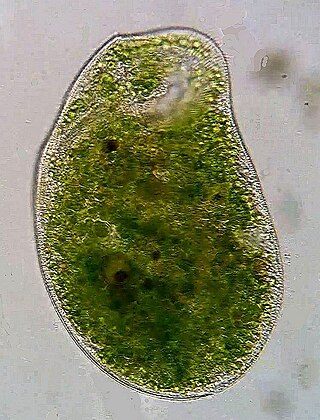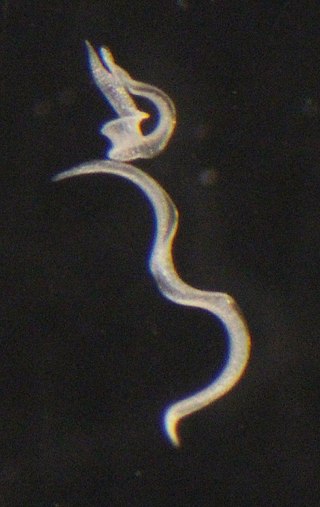
Blepharisma is a genus of unicellular ciliate protists found in fresh and salt water. The group includes about 40 accepted species, and many sub-varieties and strains. While species vary considerably in size and shape, most are easily identified by their red or pinkish color, which is caused by granules of the pigment blepharismin.

Stephanopogon is a genus of flagellated marine protist that superficially resembles a ciliate.

Stentor, sometimes called trumpet animalcules, are a genus of filter-feeding, heterotrophic ciliates, representative of the heterotrichs. They are usually horn-shaped, and reach lengths of two millimeters; as such, they are among the largest known extant unicellular organisms. They reproduce asexually through binary fission.
Karyorelictea is a class of ciliates in the subphylum Postciliodesmatophora. Most species are members of the microbenthos community, that is, microscopic organisms found in the marine interstitial habitat, though one genus, Loxodes, is found in freshwater.
Loxodes is a genus of karyorelictean ciliates, belonging to family Loxodidae. It is the only known karyorelictean ciliate that lives in freshwater habitats.

The ciliates are a group of alveolates characterized by the presence of hair-like organelles called cilia, which are identical in structure to eukaryotic flagella, but are in general shorter and present in much larger numbers, with a different undulating pattern than flagella. Cilia occur in all members of the group and are variously used in swimming, crawling, attachment, feeding, and sensation.

Euplotes is a genus of ciliates in the subclass Euplotia. Species are widely distributed in marine and freshwater environments, as well as soil and moss. Most members of the genus are free-living, but two species have been recorded as commensal organisms in the digestive tracts of sea urchins.

Frontonia is a genus of free-living unicellular ciliate protists, belonging to the order Peniculida. As Peniculids, the Frontonia are closely related to members of the genus Paramecium. However, whereas Paramecia are mainly bacterivores, Frontonia are capable of ingesting large prey such as diatoms, filamentous algae, testate amoebas, and even, in some circumstances, members of their own species. In bacteria-rich saprobic conditions, Frontonia leucas can live as a facultative bacterivore.

Climacostomum is a genus of unicellular ciliates, belonging to the class Heterotrichea.

Dileptus is a genus of unicellular ciliates in the class Litostomatea. Species of Dileptus occur in fresh and salt water, as well as mosses and soils. Most are aggressive predators equipped with long, mobile proboscides lined with toxic extrusomes, with which they stun smaller organisms before consuming them. Thirteen species and subspecies of Dileptus are currently recognized.

Climacostomum virens is a species of unicellular ciliate protists. It is one of just two formally described species in the genus Climacostomum.

Condylostoma is a genus of unicellular ciliate protists, belonging to the class Heterotrichea.

Loxodidae is a family of karyorelict ciliates.
Protoheterotrichida is an order of karyorelict ciliates. It contains the family Geleiidae.
Geleiidae is a family of karyorelict ciliates. It is sometimes synonymized with family Aveliidae.

Armophorea is a class of ciliates in the subphylum Intramacronucleata. . It was first resolved in 2004 and comprises three orders: Metopida, Clevelandellida, and Armophorida. Previously members of this class were thought to be heterotrichs because of similarities in morphology, most notably a characteristic dense arrangement of cilia surrounding their oral structures. However, the development of genetic tools and subsequent incorporation of DNA sequence information has led to major revisions in the evolutionary relationships of many protists, including ciliates. Metopids, clevelandellids, and armophorids were grouped into this class based on similarities in their small subunit rRNA sequences, making them one of two so-called "riboclasses" of ciliates, however, recent analyses suggest that Armophorida may not be related to the other two orders.

Kentrophoros is a genus of ciliates in the class Karyorelictea. Ciliates in this genus lack a distinct oral apparatus and depend primarily on symbiotic bacteria for their nutrition.
Wilbertomorphidae is a family of karyorelictean ciliates. The family is monotypic, because it contains a single genus Wilbertomorpha with a single known species, Wilbertomorpha colpoda.

Licnophora is a genus of ciliates in the family Licnophoridae. They typically have an hourglass-like shape and live as ectocommensals on marine animals.
Geleia is a genus of karyorelict ciliates in the family Geleiidae.














